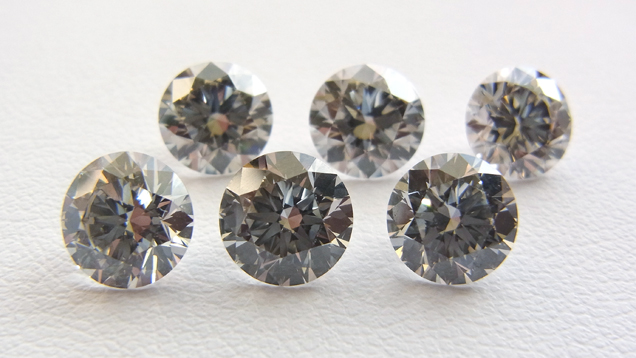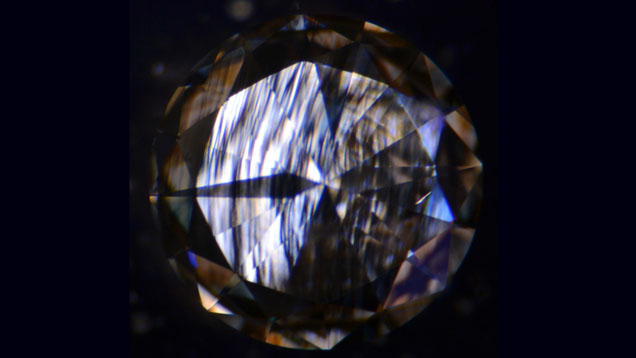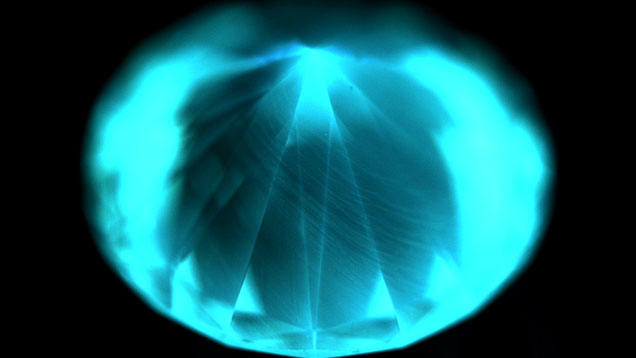Undisclosed Samples of Large CVD Synthetic Diamond

In December 2012, six CVD synthetics over one carat (figure 1) were submitted to the Tokyo branch of the Central Gem Laboratory for diamond grading. These were among the largest undisclosed samples of CVD synthetic diamond ever submitted to a gem laboratory. The six round brilliants ranged from 1.001 to 1.119 ct. All had a color grade of Light yellowish gray, and their strong grayish hue made color estimation using “Cape” series master stones difficult. Four of the samples had a clarity grade of VS1, while the other two were VS2. Four samples had cut grades of Excellent, and two were Very Good.
Each sample contained a few pinpoint inclusions, which kept the clarity grades below VVS. The dark, irregularly shaped inclusions were presumably non-diamond carbon. Some samples showed dark graphitization on the girdle. A similar feature is seen in HPHT-treated diamond, which strongly suggests that these samples underwent post-growth treatment. The characteristic streak pattern of anomalous double refraction due to strain (low-order black and white interference colors) was observed in every sample. The streaks run parallel with the growth direction of the crystal, which is perpendicular to the seed face. The patterns were elongated along the crystal’s growth direction and presumably caused by dislocation during growth (figure 2). The samples were inert to long-wave UV radiation, while some of them displayed weak greenish yellow luminescence to short-wave UV.

Figure 2. Anomalous double refraction due to stress was observed under cross-polarized filters. Contrasting black and white low-order interference colors produced the streak pattern. Photo by H. Kitawaki.
After FTIR analysis, the samples were classified as type II, which do not show any distinct absorption in the nitrogen area (1500–1000 cm–1) in diamond. Despite their yellow tint, the 1344 cm–1 absorption attributed to single substitutional nitrogen was not observed. Absorptions also originate in hydrogen at 3123 cm–1, which has been reported as a characteristic of CVD-grown diamond (W. Wang et al., “Gem-quality synthetic diamonds grown by the chemical vapor deposition method,” Summer 2012 G&G, pp. 268–283), and at 3107 cm–1, which is often seen in natural diamonds, were not recognized as clear peaks.Photoluminescence analysis at liquid-nitrogen temperatures with various excitation wavelengths revealed peaks at 637 nm (NV–), 575 nm (NV0), 503.2 nm (H3), and 737 nm (SiV–; 736.4/736.8 doublet). With 488 nm laser excitation, five of the six samples displayed a 528 nm peak of unknown origin. With 325 nm excitation, 462 and 499 nm peaks with unknown origins were detected. These two peaks are not observed in natural diamonds. Two of the samples showed a very weak peak at 415.2 nm (N3).
When tested with the DiamondView, the samples showed blue phosphorescence and greenish blue-white luminescence. This luminescence is attributed to boron doping, an enhancement that makes the stone colorless (D.S. Misra, “Method for growing white color diamonds by using diborane and nitrogen in combination in a microwave plasma chemical vapor deposition system,” International Patent No. 2012044251).
The samples also showed the layered structure image characteristic of CVD synthetic diamond (figure 3). These UV luminescence figures, unique to CVD synthetics, are more apparent from the pavilion than from the table. Some of them displayed straight growth lines or linear structures such as slip lines, and careful observation of the entire stone (especially from the pavilion) is imperative.

Figure 3. DiamondView fluorescence images showed a layered structure characteristic of CVD synthetic diamond. Blue phosphorescence, attributed to boron, was also observed. Photo by M. Hisanaga.



